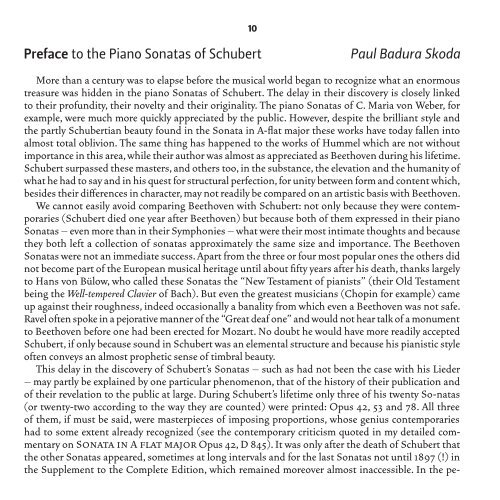Télécharger le livret - Outhere
Télécharger le livret - Outhere
Télécharger le livret - Outhere
Create successful ePaper yourself
Turn your PDF publications into a flip-book with our unique Google optimized e-Paper software.
Preface to the Piano Sonatas of Schubert Paul Badura Skoda<br />
More than a century was to elapse before the musical world began to recognize what an enormous<br />
treasure was hidden in the piano Sonatas of Schubert. The delay in their discovery is closely linked<br />
to their profundity, their novelty and their originality. The piano Sonatas of C. Maria von Weber, for<br />
examp<strong>le</strong>, were much more quickly appreciated by the public. However, despite the brilliant sty<strong>le</strong> and<br />
the partly Schubertian beauty found in the Sonata in A-flat major these works have today fal<strong>le</strong>n into<br />
almost total oblivion. The same thing has happened to the works of Hummel which are not without<br />
importance in this area, whi<strong>le</strong> their author was almost as appreciated as Beethoven during his lifetime.<br />
Schubert surpassed these masters, and others too, in the substance, the e<strong>le</strong>vation and the humanity of<br />
what he had to say and in his quest for structural perfection, for unity between form and content which,<br />
besides their differences in character, may not readily be compared on an artistic basis with Beethoven.<br />
We cannot easily avoid comparing Beethoven with Schubert: not only because they were contemporaries<br />
(Schubert died one year after Beethoven) but because both of them expressed in their piano<br />
Sonatas – even more than in their Symphonies – what were their most intimate thoughts and because<br />
they both <strong>le</strong>ft a col<strong>le</strong>ction of sonatas approximately the same size and importance. The Beethoven<br />
Sonatas were not an immediate success. Apart from the three or four most popular ones the others did<br />
not become part of the European musical heritage until about fifty years after his death, thanks largely<br />
to Hans von Bülow, who cal<strong>le</strong>d these Sonatas the “New Testament of pianists” (their Old Testament<br />
being the Well-tempered Clavier of Bach). But even the greatest musicians (Chopin for examp<strong>le</strong>) came<br />
up against their roughness, indeed occasionally a banality from which even a Beethoven was not safe.<br />
Ravel often spoke in a pejorative manner of the “Great deaf one” and would not hear talk of a monument<br />
to Beethoven before one had been erected for Mozart. No doubt he would have more readily accepted<br />
Schubert, if only because sound in Schubert was an e<strong>le</strong>mental structure and because his pianistic sty<strong>le</strong><br />
often conveys an almost prophetic sense of timbral beauty.<br />
This delay in the discovery of Schubert’s Sonatas – such as had not been the case with his Lieder<br />
– may partly be explained by one particular phenomenon, that of the history of their publication and<br />
of their revelation to the public at large. During Schubert’s lifetime only three of his twenty So-natas<br />
(or twenty-two according to the way they are counted) were printed: Opus 42, 53 and 78. All three<br />
of them, if must be said, were masterpieces of imposing proportions, whose genius contemporaries<br />
had to some extent already recognized (see the contemporary criticism quoted in my detai<strong>le</strong>d commentary<br />
on Sonata in A flat major Opus 42, D 845). it was only after the death of Schubert that<br />
the other Sonatas appeared, sometimes at long intervals and for the last Sonatas not until 1897 (!) in<br />
the Supp<strong>le</strong>ment to the Comp<strong>le</strong>te Edition, which remained moreover almost inaccessib<strong>le</strong>. in the pe-<br />
10


